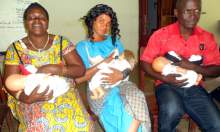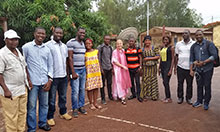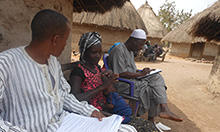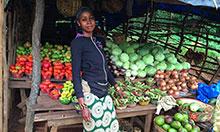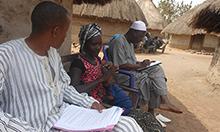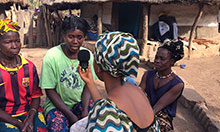Executive Summary
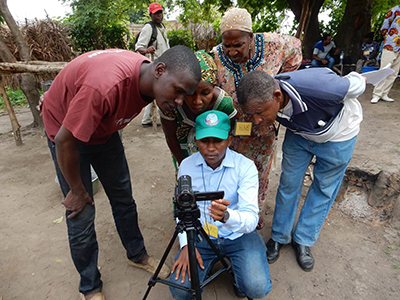
In 2016, the SPRING project began providing technical assistance in Guinea with funding from USAID’s Bureau of Food Security (BFS) to test small-scale approaches for improving dietary diversity within the prefecture of Faranah. During the summer and fall of 2015, we had conducted a nutrition assessment to help inform BFS investments in nutrition-specific and nutrition-sensitive actions that would complement other donor and government investments to address stunting and anemia.
Through this assessment, we found a number of institutional and contextual factors that were contributing to the high rates of undernutrition and lack of diversified, quality diets in Guinea. These included poverty, food insecurity during the hunger season, poor hygiene, and insufficient dietary diversity related to food availability, as well as food choices, household feeding practices, hygiene and sanitation, and access to information. Furthermore, although a network of agriculture extension workers is in place, they have limited resources, supplies, and education materials.
In fiscal year (FY) 16, with funding from BFS, we worked through our local partner, Winrock International, to test approaches for increasing demand for and consumption of diverse, nutrient-rich foods at the household level, as well as approaches for increasing access to and quality of nutrition-sensitive agricultural services. Additionally, we collaborated with partner Digital Green to disseminate nutrition messages through a community video platform.
In FY17, we worked in close consultation with Winrock International to design activities for the newly awarded Strengthening Market-Led Agricultural Research, Technology, and Education (SMARTE) project. These activities included work with community radio, community video, and development of a variety of nutrition-sensitive agriculture tools.
SPRING in Guinea
Background
In 2015, the USAID Bureau for Food Security (BFS) provided post-Ebola response funding to the SPRING project through the agency’s Guinea Mission as part of broader efforts within the region to spur recovery from the Ebola crisis of 2014–2015. SPRING conducted an initial assessment between July and October 2015, to examine the impact of the Ebola crisis on household practices, local services, agricultural production, and food security in Guinea, and its relationship to high levels of undernutrition, including stunting and anemia. We brought nutrition, agriculture, and social and behavior change (SBC) experts together to review the current nutrition context, with emphasis on women and children under two years of age.
This initial assessment found that the food security and nutrition situation faced significant challenges even before the Ebola crisis, and that the crisis had badly disrupted health and agricultural services. The assessment findings pointed to poor household hygiene and care practices, as well as inadequate household diets, as major contributors to poor nutrition. For example, in 2013, only 4 percent of children had a minimal acceptable diet and only 6 percent had a minimally diverse diet (consisting of four or more food groups). Based on the assessment, we recommended a focus on increased access to and demand for nutrient-rich vegetables and animal-sourced foods, the consumption of these foods by women and children, and improvements in household hygiene and care practices.
SPRING Goals and Objectives
Based on the full range of findings and recommendations from the initial assessment, the BFS in Washington provided funding for SPRING to design and implement a one-year program under a modest complementary post-Ebola response investment. This was followed by an additional year of programming, funded by USAID/Guinea. Given the short timeframe available, our primary goal in Guinea was to contribute to nutrition efforts by improving dietary diversity among households with pregnant and lactating women and children under the age of two in Faranah prefecture. We are supporting the overarching Feed the Future objectives of improving nutritional status, leveraging agricultural productivity, and strengthening income generation.
We focused our interventions on developing and testing approaches to promote nutrition-specific behaviors and nutrition-sensitive agriculture practices, sharing lessons learned, and encouraging cross-sectoral collaboration. A number of SBC approaches focused efforts on key behaviors related to improving dietary diversity; maternal, infant, and young child nutrition (MIYCN); and improved hygiene. Rather than establish a new SPRING country office, which would have taken time away from program activities, we worked with and through local agencies with an established presence in Faranah; the primary partner for this activity was Winrock International. In addition, our activities helped inform newly developed programs within the Feed the Future zone of influence, such as the Strengthening Market-Led Agricultural Research, Technology, and Education (SMARTE) project, led by Winrock International.
SPRING Intervention Area
Based on discussions with USAID and the recommendations from the nutrition assessment conducted in fiscal year (FY) 2015, we focused our technical assistance on the prefecture of Faranah. In FY17, we continued to work in Faranah, in close collaboration with the SMARTE project, which was also based in this region and eventually expanded activities to the Mamou prefecture (see Figure 1).
Figure 1. Map of SPRING-Supported Areas in Guinea
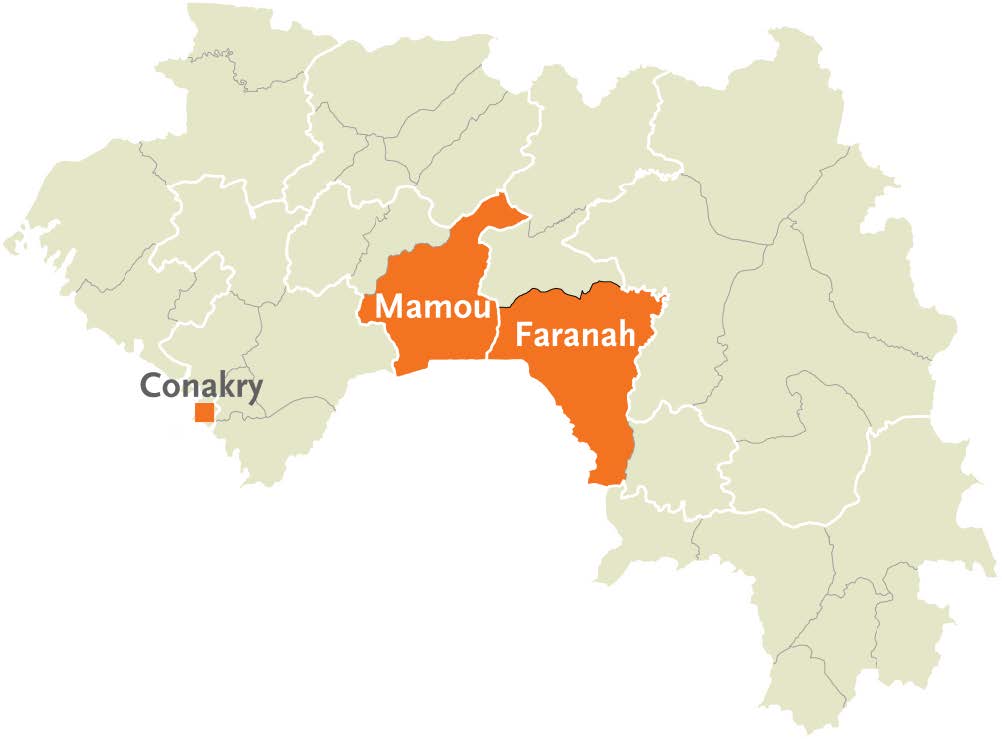
Major Accomplishments
SPRING’s major accomplishments in Guinea fall into two categories: nutrition-sensitive agriculture and social and behavior change communication (SBCC). These approaches both inform and reinforce one another.
Social and Behavior Change Communication
SPRING’s work in Guinea built on our learning around effective SBCC strategies from our activities in other countries. Through partnerships and collaboration with local stakeholders, we expanded our scope to explore the use of SBCC in a multi-sectoral program environment, and built local capacity to incorporate SBCC, nutrition, and WASH (water, sanitation, and hygiene) within agriculture institutions. In FY16, we conducted a formative research assessment to explore local hygiene behaviors and examine feeding practices for children 6–23 months old and for pregnant and lactating mothers, which informed the development of nutrition-related SBCC materials. To find ways to increase consumption of a diverse diet, we placed particular emphasis on exploring the value chain for nutrient-rich crops. Findings from this research informed our SBCC approach, including our work with community video and radio.
Community Video
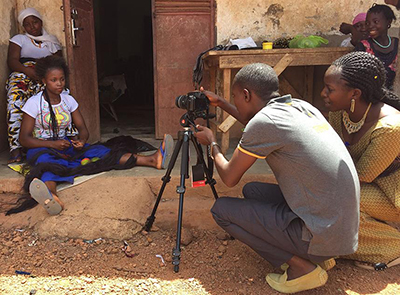
SPRING’s community video work was an innovative approach in Guinea, using local actors to create and disseminate videos that were then used to spark discussions with groups of mothers and their family members to promote MIYCN and nutrition-sensitive agriculture practices. Working with our partner, Digital Green, we have used the community video platform to put low-cost technology in the hands of community volunteer moderators. As part of our effort to build capacity in community video, we trained a video production team (“hub”) in Faranah. We worked with the Faranah hub to create five videos with messages about nutrition-sensitive agriculture, MIYCN, and WASH.1 We then tested out a community video dissemination platform by identifying and training volunteer moderators and hub members on community dissemination of videos and on MIYCN. This experimental group trained 240 mothers and their household members on household MIYCN, WASH, and nutrition-sensitive agriculture practices using monthly video projection and discussion meetings, as well as regular home visits to support uptake of the practices promoted in the videos.
Given the enthusiastic acceptance of community video by villagers and partners at all levels, and on the cost-effective and quick production of high quality of videos, we expanded our video work in collaboration with SMARTE. Together with Winrock International, we identified community video as a promising approach for delivering extension and other behavior change services through SMARTE’s network of stagiares (AVENIR agents). We trained and established a new video production hub in the city of Mamou, where SMARTE is also operating.We then expanded our already established community video work to support market-led nutrition-sensitive agriculture activities. Our adapted community video approach supports AVENIR agents who are placed to work with agricultural organizations, such as producers’ cooperatives, input suppliers, and agricultural service providers. These agents support the uptake and proper use of appropriate technologies selected by Winrock International. These technologies focus on increasing food security and improving nutrition for women and children under two.
Our community video approach has proved to be well accepted, adaptable for a range of topics, and sustainable within the project area; following the closeout of SPRING activities in Guinea, the SMARTE project and others have contracted with the video production hubs to develop a series of community videos to promote the uptake of nutrition-sensitive agriculture practices. Community video remains a popular way to promote behavior change in local communities in Guinea. As one beneficiary reported, “I changed my diet because of the video. The importance of watching this video is very big. If they tell you about things, usually you won’t believe, but if you see it for yourself, you will believe it.”
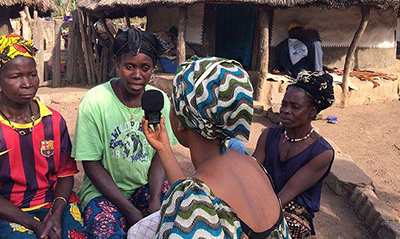
Interactive Radio
Recognizing that community radio is a major source of information for the communities where we work in Guinea, SPRING collaborated with Farm Radio International (FRI), an international nongovernmental organization (NGO), to conduct an assessment of local radio stations Radio Bambou and Radio Rurale in Faranah and Radio Rurale and Radio GPP in Mamou as potential SBCC partners. All radio stations have a wide reach, and staff from all stations showed a strong interest in collaborating with SPRING to conduct radio campaigns and other relevant SBCC programming.
We then expanded our SBCC work to include building the capacity of local radio stations to support SMARTE’s use of community radio in promoting key behaviors. Based on the assessment results, we trained the abovementioned radio stations in interactive radio2 and created a rollout plan for SMARTE, detailing how the project could use community radio to improve nutrition in Guinea by having listeners call in to shows for answers to their questions about nutrition-sensitive agriculture practices. The rollout plan recommends introducing interactive radio in two phases to ensure the SMARTE project can further implement interactive radio programs at scale to better promote improved nutrition-sensitive agriculture practices. This will lay a foundation for more in-depth use of interactive radio. In the first phase, SMARTE is taking advantage of capacity that has already been built with the four Faranah and Mamou radio stations to introduce small-scale programming. In the second phase, we recommend that SMARTE and/or other actors invest resources to conduct more in-depth interactive radio campaigns aimed at achieving greater uptake of the promoted practices.
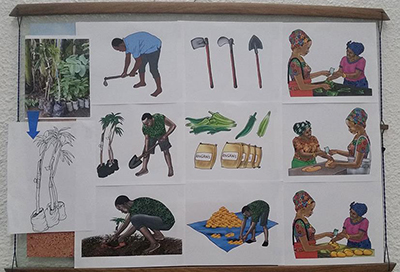
Photo-to-Illustration
The photo-to-illustration (PTI) process allows graphic artists to use photographs from the community as a reference to develop high-quality illustrations that are technically accurate, culturally acceptable, and attractive to audiences. These illustrations can be used to support SBC activities by engaging audiences with appealing and culturally appropriate cues for key behaviors. In Guinea, SPRING facilitated a six-day training on the PTI process3 for 14 participants, including artists from the Guinean cartoonist cooperative, La Bulle d’Encre (The Ink Bubble), Peace Corps volunteers and staff, and representatives from Helen Keller International in Sierra Leone (which is working with Feed the Future partners in that country). Participants learned and practiced the technique in their current programs, producing materials on consumption of fish and the cultivation of coffee. By training local artists as well as Peace Corps volunteers living in the field, our hope is to bring the material-design process as close as possible to the communities where these illustrations will be used, thus giving local voices more input in their development. Shortly after the workshop, participants were approached by a number of partners to help them develop PTI-based SBCC materials.
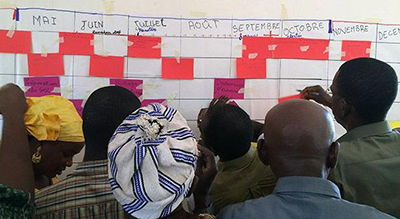
Nutrition-Sensitive Agriculture
A large piece of SPRING’s work in Guinea has centered on training our partners in nutrition-sensitive agriculture. In FY16, we provided training to local partners and community members on the USAID/SPRING Pathways to Improving Nutrition through Agriculture, and how to apply these tools in the Guinea context. Participants included faculty and students from ISAV (Institut Supérieur Agronomique et Vétérinaire); staff from Faranah-based NGOs GUIDRE (Guinée Développement Rural et Environnement) and APIC (Association pour la Promotion des Initiatives Communautaires de Guinée); UNICEF-funded Search for Common Ground; the regional agricultural ministry; and ANPROCA (Agence Nationale de la Promotion Rurale et du Conseil Agricole).
Agricultural experts from ISAV prioritized promotion of key nutrition-sensitive agriculture practices associated with the cultivation of specific nutrient-rich crops in the off-season as well as key MIYCN practices. The training provided participants with tools and approaches to enable them to understand the linkages between agriculture and nutrition through three important pathways: production, revenue, and women’s empowerment.
Testing New Approaches
Based on findings from formative research SPRING conducted in FY16, we decided to test a new approach to increase the availability of nutrient-dense foods (cowpeas and sweet potato leaves) to improve intake of protein and vitamin A among pregnant women and children 6–23 months during the dry season. SPRING worked with two women’s groups, who built demonstration plots to show how to grow cowpeas and sweet potato leaves at the end of the dry season. A total of 50 group members (48 women, plus two male agricultural extension workers) worked on the plots in the hope of extending the growing season and increasing crop production. Participants planted sweet potato leaves and cowpeas in late May 2016, approximately 1.5 months in advance of the customary planting season.
While the new approach succeeded quite well for sweet potato leaves, it did not achieve the anticipated outcomes for cowpeas, which produced fewer beans than the variety normally grown during the rainy season. Based on these valuable findings, local agriculture experts recommended that a better option for increasing cowpea consumption (and achieving increased protein intake) by women and children during the dry season would be to focus on improved storage techniques for cowpeas in order to reduce post-harvest losses.
(For details, visit this page.)
Another major part of SPRING’s work has centered on the development of a nutrition-sensitive agriculture module,4 to be incorporated into the training curricula for SMARTE’s AVENIR agents. As a first step, we assessed potential nutrition-sensitive agriculture practices (within the value chains of rice, horticulture, and livestock) that could be integrated into SMARTE project activities in Guinea. Our assessment team conducted 20 interviews with producers, processors, input suppliers, researchers, and government ministries across the different value chains, including other partners from Feed the Future’s Guinea Agriculture Services (GAS) project, looking for practices that AVENIR agents could market (or link to a marketable service that AVENIR agents could provide). We identified a total of 15 recommended practices for rice, vegetables, fruit, livestock, and cross-cutting interventions. Based on the assessment findings, we tested and refined a one-day nutrition-sensitive agriculture training module that was integrated into the AVENIR agents’ training program. The module features methods for incorporating improved agricultural technologies into value chains to make them more nutrition-sensitive.
Best Practices, Challenges, and Recommendations
A major challenge SPRING faced in Guinea related to the fact that, as a market-led project, video production and dissemination need to be financed by entities that have a market incentive to sell key agriculture technologies and services. As with many market-led activities, there may be a strong short-term market incentive to focus on the sale of a specific technology or service (such as a forced-air vegetable dryer) but little motivation to encourage customers to adopt improved practices after sale (especially nutrition and hygiene practices). This gap could prove challenging to the prolonged uptake of a specific practice promoted through community video, especially if that practice is not linked to the sale of a product.
We also faced the challenge of adapting our village-based community media approach, which traditionally works with mothers’ groups, for a market-led model. We collaborated closely with our partner Winrock International to transform community video production and dissemination to work in a market context. In addition to initiating the use of small, mobile pico projectors for video projection, we have developed and trained AVENIR agents in a dissemination methodology that incorporates the use of tablets and smartphones for video dissemination at agricultural input supply stores, markets, and in other settings. We have shared this new approach in global forums, such as the ICT4Ag Conference and the SEEP Conference.
In FY17, we focused primarily on supporting the newly awarded SMARTE project. Unfortunately, we experienced some timing challenges. While SPRING had been active in Guinea a year before SMARTE was awarded, SMARTE was in “start-up” mode during a large part of FY17. Despite the very rapid start-up of SMARTE, the mismatch in scheduling limited our ability to provide more timely technical support. For example, we had originally planned to build AVENIR agents’ capacity in nutrition-sensitive agriculture, but the agents were not selected until later in the year. Fortunately, we were able to create a nutrition-sensitive agriculture training module for them. SMARTE has begun using this module, but we would have liked more time to provide follow-up to the AVENIR agents.
Evidence shows that the probability that an individual will adopt a new behavior increases if they receive the same message through more than one channel. To increase the reach and depth of messages promoting relevant nutrition-sensitive agriculture practices, we worked with community radio stations. Complementary radio broadcasts raised awareness about specific technologies or services that further reinforced key video messages. These broadcasts were designed to stimulate conversations with curious farmers on details of specific practices. To further the sustainability of these efforts, Feed the Future partner Winrock International has incorporated these approaches into their program.
We have also learned that establishing video production hubs is a good way to ensure sustainability of the community video approach. Winrock International has approached the video production hubs trained by SPRING to develop 14 community videos on nutrition-sensitive agriculture practices, and plans to work with community radio stations and illustration artists trained by SPRING to promote the uptake of key nutrition-sensitive agriculture practices. In addition, private businesses and other NGOs have approached the SPRING-trained hubs to produce videos for them, independent of Winrock.
To educate other partners both in and outside Guinea on the benefits of community video, we have created a short documentary video illustrating our experiences in the country. The seven-minute video can be viewed here.
Footnotes
1 SPRING/Guinea’s community videos can be viewed at https://www.spring-nutrition.org/media/videos/improving-nutrition-through-community-video-guinea
2 https://www.spring-nutrition.org/about-us/news/guinean-radio-stations-trained-promote-nutrition-sensitive-agriculture
3 https://www.spring-nutrition.org/media/galleries/photo-illustration-process-examples-springs-workshop-guinea
4 For details, see https://www.spring-nutrition.org/media/galleries/springguinea-staff-nutrition-sensitive-agriculture-training
References
SPRING. 2015. Guinea Nutrition Assessment. Arlington, VA: Strengthening Partnerships, Results, and Innovations in Nutrition Globally (SPRING) project.
SPRING. 2017. Guinea: Formative Assessment of Household Maternal, Infant, and Young Child Nutrition and Hygiene Practices: Informing Community Video Content. Arlington, VA: Strengthening Partnerships, Results, and Innovations in Nutrition Globally (SPRING) project.
